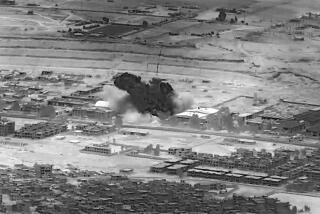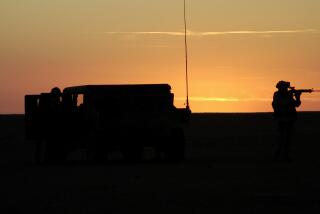A Deadly Surge
- Share via
A year and a half ago, at the first anniversary of the U.S. occupation of Iraq, the death rate for American troops accelerated. Since then, none of the political milestones or military strategies proclaimed by U.S. officials have succeeded in slowing the toll.
This is among the most striking conclusions of a Times analysis of the fatalities, which have reached 2,000, U.S. officials announced Tuesday.
Two other findings stand out:
* The number of deaths attributed to roadside bombs has sharply increased. The bombs have overtaken rockets, mortars and gunfire as the greatest threat to U.S. troops and were responsible for more than half of combat deaths in the last year.
* The war has taken a growing toll on National Guard and reserve units. Their soldiers now account for nearly one-third of the deaths, up from one-fifth earlier in the conflict.
The analysis compared the first 1,000 deaths -- from the beginning of the war in March 2003 through early September of last year -- with the fatalities since.
For the first year after the capture of Baghdad, the deaths of American soldiers accumulated slowly -- about one a day. Then, on March 31, 2004, shortly after the anniversary of the invasion, four American contractors were slaughtered in the Sunni-dominated city of Fallouja, west of Baghdad.
In America, the picture of contractors’ charred bodies hanging from a bridge signaled to the public that the insurgency had intensified. In Iraq, the death rate for U.S. troops roughly doubled after that point.
Since then, the military has added armor to its trucks and has assaulted insurgent strongholds in Fallouja, Ramadi and the deserts of western Al Anbar province. U.S. trainers have worked to toughen Iraqi combat units, saying they hoped to get American troops off Iraq’s streets and rely more on Iraqis for security. U.S. leaders transferred sovereignty back to Iraq and pushed for elections and the drafting of a constitution, which was approved this month by Iraqi voters. Saddam Hussein has gone on trial.
None of that appears to have substantially affected the U.S. death rate. Despite blips up and down, the overall trend since the Fallouja incident -- an average of roughly 17 deaths a week -- has continued unabated.
One hundred nineteen American troops died in the initial three-week campaign to capture Iraq. One thousand eight hundred eighty-one more Defense Department personnel, including five civilian Pentagon employees, have now died trying to hold it. About 15,000 American troops have been wounded, with about half hurt too severely to return to duty.
The soldiers, Marines and sailors who died came from every state -- more than 1,400 cities and towns, large and small, across the country.
About 200 soldiers from countries allied with the United States also have died, just under half of them British. Thousands of Iraqis on both sides have been killed as well, with the best “guesstimate” of civilian fatalities being somewhere between 26,000 and 30,000, according to Anthony Cordesman of the Center for Strategic and International Studies in Washington.
Many of the military deaths have resulted from roadside bombs. Among the victims was Pfc. Devin J. Grella, a 21-year-old soldier in the Army Reserve’s 706th Transportation Company based in Mansfield, Ohio. Grella had been in Iraq several months when he died Sept. 6, 2004. He was driving a fuel truck as part of a convoy heading west from Baghdad to Fallouja, where supplies were being delivered to a group of Marines. The troops had left the capital after dark, said his father, Dennis Grella, 57. Devin Grella’s vehicle was in the middle of the convoy.
The convoy was attacked twice on the road, and snipers shot at it. Then, a bomb hidden on the road exploded next to the driver’s side of Grella’s vehicle.
“The military told us that it was remotely detonated,” Dennis Grella said. “They said it hit just about where he was sitting. The walls were punctured, and the tank caught fire. He wasn’t able to get out of the truck.” Devin Grella burned to death.
Improvised explosive devices, as American military officials call them, “are that hidden monster you’re always aware of,” said Sgt. Chip Lilly, a 35-year-old contractor from Staunton, Va. He serves with the Army National Guard near Tall Afar, a city of roughly 200,000 in northern Iraq.
“The more unnerving part of it is -- you know they’re out there, but you can’t find all of them,” said Lilly, whose Humvee was hit the first time he drove through Tall Afar a few weeks ago.
A U.S. commander recently told reporters in Tall Afar about a school for bomb makers at which local Baath Party retirees with knowledge of engineering tutored insurgents, using chalkboards and manuals to explain the craft of designing and hiding explosives. In one instance, U.S. soldiers watched from a distance as an instructor showed about 30 people gathered outside a school how to bury explosives, said Col. H. R. McMaster, commander of the Army’s 3rd Armored Cavalry Regiment.
“It’s the easiest way for them to attack both Iraqi and coalition troops,” said National Guard Capt. Christopher Zimbardy, a 35-year-old truck parts salesman from Philadelphia. “I hate long rides -- it’s really stressful.”
Army Lt. Col. Steven Boylan, a spokesman for U.S. forces in Iraq, said explosives “can be found on the side of the road, buried in the road, in cars; they have been found in dead animals. Almost anything can be used to hide them.”
At the Pentagon, officials used to talk hopefully about how improving the armor on military vehicles would solve the problem of roadside bombs. Instead, insurgents have improved their explosives -- U.S. officials have suggested some sophisticated bombs are now being imported from Iran -- and the hope that armor would counter them has largely dissipated.
“We think that we’re smart, but the bad guys keep getting smarter,” said one Pentagon official, speaking on condition of anonymity because he is not authorized to speak on the record.
Grella was in several ways typical of the U.S. soldiers killed in Iraq -- an Army enlisted man (98% of the dead have been male), in his 20s (the average age was 26) and white (Pentagon figures show whites, blacks, Latinos and Asian Americans dying in numbers roughly proportionate to their share of the U.S. population.)
Often, the reservists killed were, like Grella, conducting combat support operations. These have been increasingly deadly as insurgents have learned to target U.S. supply convoys.
The ranks of regular Army troops have also been ravaged by explosives.
Army Pfc. Jeffrey R. Wallace, 20, was another of the hundreds of victims of roadside bomb attacks in the last year. He and two other soldiers were killed May 24 when a roadside bomb detonated next to their Humvee as it crossed a bridge over the Tigris River in Baghdad.
Friends and family said Wallace, who had been a high school football player in the small, central Illinois town of Hoopeston, had joined the Army partly because his grandfather had served in the military, partly because he felt a need to join other friends and acquaintances and get into the fight, partly because he hoped to use the money he earned to go to college.
A few months before he shipped out to Iraq last winter, he married his longtime friend and recent sweetheart, Sarah, during a two-week leave from his base at Ft. Stewart, Ga. By the time he returned to base, Sarah was pregnant. Their daughter, Ava Grace, was born four months after his death.
When he notified the family of Wallace’s death, a military bereavement officer told them that all that remained of Jeffrey was “body parts that had to be scraped out of that Humvee,” according to Sarah’s mother, Karen Gossett, 51. His remains fit into a small box. The box was put in the casket, and his uniform was placed on the box. His medals were pinned to the uniform. Then the casket was closed.
*
Smith reported from Los Angeles and Huffstutter from Hoopeston. Times staff writers Louise Roug in Tall Afar, Borzou Daragahi in Baghdad, Mark Mazzetti in Washington and David Lauter in Los Angeles and data analyst Sandra Poindexter in Los Angeles contributed to this report.
More to Read
Sign up for Essential California
The most important California stories and recommendations in your inbox every morning.
You may occasionally receive promotional content from the Los Angeles Times.











